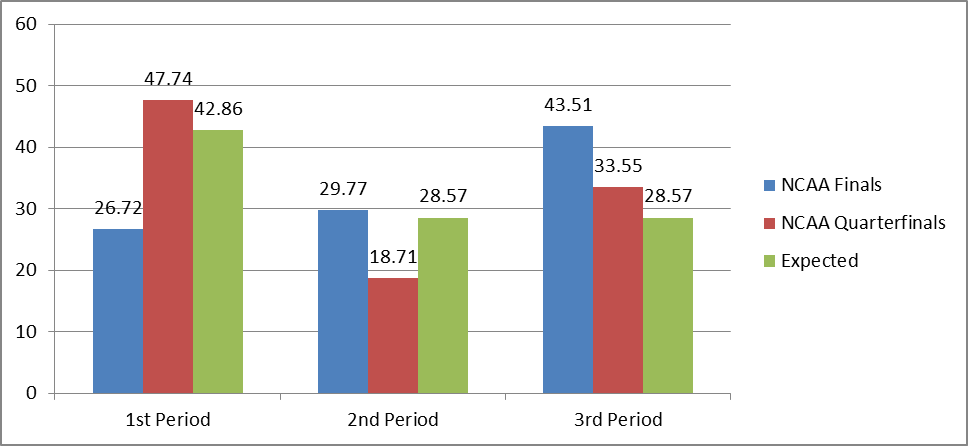More D1 Quarterfinal Analysis
Last summer, I wrote an article for TheOpenMat.com analyzing the technique in the 2013 NCAA Division I quarterfinal round. You can see that article here: Andy Vogel: 2013 Quarterfinal Analysis
I have now watched the 2014 quarterfinals and added that information to the spreadsheet tracking last year’s data. You can find that spreadsheet here: NCAA Quarterfinals Takedowns
There are three tabs to that spreadsheet. One is for 2013, one is for 2014, and one is for the two years combined. This combined data set encompasses 80 matches over two years, so we are starting to get to a point where some of the noise in the data is ironed out. I want to do two things with this post. First, I will quickly go over my ten points from last year’s article to see how the conclusions hold up with twice as much data. Second, I want to address some of the points brought up in the following two articles posted by Chris Orzechowski as it relates to my data. Article 1 | Article 2
Here are the ten points from the original article, along with appropriate comments
1. The single leg takedown is still supreme
This is still demonstrably true. 46% of takedowns were singles in 2013, and 44% were in 2014
2. Wrestlers must be able to finish without getting to their feet
3. The high crotch is missing in action
It is not missing so much in 2014. This was the point that seemed most likely to be an issue of a small sample size, and 2014 bore that out. After seeing just one high crotch in the 2013 quarters, there were nine in 2014. I believe the general conclusion in the initial article is still correct, as those who scored with a hi-c cut across and finished very quickly. Those that failed to finish quickly were stalemated out of the position.
4. Good wrestlers rarely give up points on their own attacks
This is especially true when the attacker gets to the legs.
5. Wrestlers cannot rely on defensive scrambling to score
There were many instances of wrestlers getting initiating scrambles to avoid giving up points, but there were still very few instances where the defensive scrambler actually scored. The next question is whether the defensive wrestlers were actually trying to score or just working for a stalemate.
6. The fireman’s carry is all but gone in NCAA wrestling
Still true! If you have a great fireman’s but want to be a great college wrestler, you need to add another attack immediately.
7. An opponent on his knees is vulnerable to an overtie shrug or slide by
I did not see this in 2014, but it may be back in 2015 with Hunter Stieber back from a redshirt year. He is really good at this.
8. Even if a wrestler does not score, excellence on top is rewarded
9. Wrestlers, even very good ones, have trouble adjusting during the match
At the very least, all wrestlers need to develop an effective attack to each side.
10. Referees could call stalling sooner to spur action
This is getting worse, not better. Unfortunately, there are some very talented wrestlers out there who have figured out the officials’ unwillingness to call stalling, and they are doing a lot of boring winning.
Lastly, and I did not track this in 2013 for comparison, 22 of the 40 2014 quarterfinal winners either scored a riding time point or won by fall. None of the losers scored a riding time point.
Now, to address the articles posted by Chris Orzechowski. His articles used the 2012-2014 NCAA finals as his data set. The first article started off with some great points that echoed what I found in the 2013 analysis and was backed up by the 2014 addition to the data. The single leg is the dominant takedown, and it’s not that close. My article and his looked at different matches but came to the same conclusion, so I am pretty confident in that result. Looking at scoring in the matches, Orzechowski concludes that singles, stand ups, and mat returns are very important due to the relative frequency of those techniques and scoring riding time points.
There is one other conclusion in the article I want to address, however. 85% of NCAA Champions from 2012-2014 scored the first takedown, so it is concluded that it is imperative that wrestlers score first if they want to win. I am sure there is a connection between the first takedown and winning, but I think the causality is backwards. Wrestlers do not win because they get the first takedown. Wrestlers get the first takedown because they are better than their opponent and thus more likely to win. The idea that you should emphasize scoring first while coaching remains good advice if the goal is to help wrestlers develop a successful attacking style.
The second article qualifies the statements about scoring first, revealing that scoring first is no more important than scoring any other time. Where things got interesting was in the discussion of the timing of scores. In the 30 NCAA finals matches examined in the article, it was determined that there were approximately 50% more points scored in the 3rd period than either the 1st or 2nd period. Curious to see if this held up in the quarterfinals, I did my own analysis. I only had information about takedowns, so that will have to stand in for points, but the lack of near fall points at this level should mean the comparison is at least decent. Here are the takedown statistics for the full 80 match data set.
Takedowns by Period for Winners and Losers in 2013-2014 NCAA Divison I Quarterfinals
| 13 & ’14 | 1st | 2nd | 3rd | OT |
| Winner | 63 | 26 | 36 | 5 |
| Loser | 11 | 3 | 16 | 0 |
| Total | 74 | 29 | 52 | 5 |
We can compare my data with that in the article, keeping in mind that the article uses all points while my data uses only takedowns. I am leaving out overtime takedowns in the chart below because I cannot tell if they were included in the Orzechowski’s data. The big caveat is the difference between points and takedowns. This could come into play in the 2nd and 3rd periods, as those periods usually feature at least one escape.
Scoring/Takedown Percentage Comparison

I believe this chart shows the difference in quality between wrestlers in the finals and quarterfinals. There are still some significant mismatches in the quarterfinals, whereas the finals should ostensibly be the top two wrestlers at each weight. Thus, the matches will have less variance and could come down to things like conditioning as stated in Orzechowski’s second article. In the quarterfinals, a better wrestler can get out to a bigger lead, making late scoring less important. I think that is exactly what happens in the quarterfinals. You can see that the winning wrestlers have a huge advantage in 1st period takedowns, but a much smaller advantage in the 3rd period. In fact, the 3rd period is when the losing wrestlers scored the most, possibly because you sometimes have a better conditioned, but less talented wrestler trying to fight his way back from a deficit.
I am grateful to Orzechowski for taking the time to write his articles to help move the conversation forward. If you have not yet read his articles, I highly encourage it.
